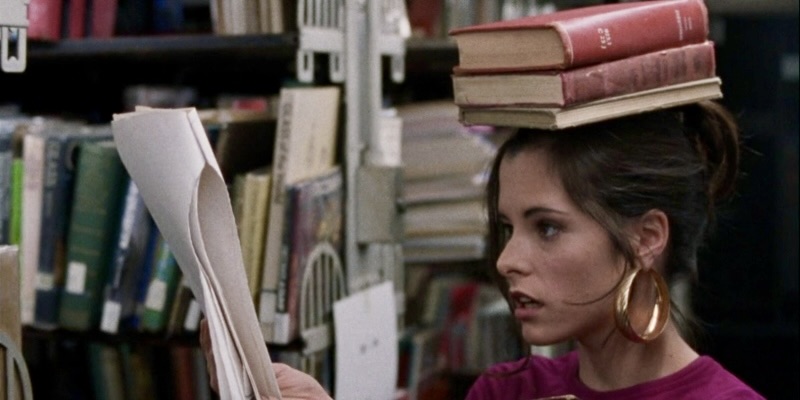Party Girl, the directorial debut of filmmaker Daisy von Scherler Mayer, is a 1995 indie flick starring the reigning ‘queen of the arthouse’ Parker Posey. It follows Posey’s character Mary, who is exactly what the title insinuates—an unaffected club rat partying her way through life. Mary is a 23-year-old ‘freelancing’ college grad living in a pre-gentrified lower Manhattan with a penchant for parties, killer designer clothes and little else. The film follows her as she’s bailed out after getting busted throwing an illegal party, and consequently takes up a job at the library her godmother works at to prove she’s capable of being a competent adult. What initially starts as a weak attempt to satiate her overbearing godmother quickly becomes something of a revelatory moment, as Mary realises not only is she passionate about her job, but good at it too. The film concludes with Mary declaring that she’s going back to school to get her master’s in library sciences before hitting the dancefloor to celebrate her 24th birthday.

So, exactly 30 years on, and following a well-overdue 4k restoration, you could argue that Party Girl is coming back in a big way. I would argue that it never went anywhere to begin with. Its reverberations of ‘cool’ have echoed through several ecospheres both physical and digital over the years, from indie cinemas to Blockbusters, old-internet blogs to short-form video platforms, a trajectory that is fitting considering it was the first feature film to be streamed over the internet shortly after its release. One search for the film on TikTok pulls up results of glitzy video edits set to 90s Björk tunes with tens of thousands of likes.
The film has captured hearts and minds for decades now for a whole multitude of reasons. It expertly weaves together many threads, which come to form a diverse portrait of the city that anyone from a metropolitan area can relate to—New York native or not. Although Mary is the main focus of the movie we are also introduced to a colourful ensemble of drag queens, club kids and NY locals through which von Scherler Mayer and co-writer Harry Birckmayer are able to introduce dialogues on the hostility of gentrification for migrant communities, the gender politics of library work and the significance of nightlife spaces for groups outside and beyond the mainstream. Nightlife is framed as a force with the potential to lead people astray, but also a means of community building and escapism from the drudgery and aimlessness that accompanies day to day life, especially as a young person looking for purpose.
It also helps that despite being truly insufferable at moments, Mary is whip-smart and immaculately well-dressed. I would be doing the film a complete disservice to gloss over the exceptional costuming which was a huge factor in establishing Party Girl as the cult classic we know today. This was part of the magnetising draw that pulled me into the orbit of this film a few years ago. As someone who finds the act of dressing up to go dancing to be sacrosanct, the opening image of Mary being arrested in that stunning blood-red Vivienne Westwood bustier top is one that was permanently singed into my grey matter upon my first watch.
Owing to a shoestring budget, costumer Michael Clancy, along with the rest of the cast and crew, had to get resourceful. Mary’s looks are a symbiotic amalgamation of designer, loaned from friends of the production and Parker’s own personal closet, and vintage thrift store gems. This situates Mary in this uniquely crafted space somewhere between the concepts of high brow and low brow. Straddling the barriers between high and low imagery is a sentiment reiterated by some of the biggest contemporary scenesters right now, with actress Rachel Sennott and musician Charli XCX both sharing their love for the film. With Charli the influence of Party Girl is especially prominent when looking at the rollout of her last record Brat, and the ‘365 Party Girl’ persona she inhabits on there. In fact, Charli’s appreciation of Party Girl runs so deep that she programmed a screening of the film as part of her Brat Collection takeover season at the Roxy Cinema in New York, which is a testament to the film’s sphere of influence and its continued legacy.
In an era when the cost of living has skyrocketed while wages remain stagnant, young people are reaching adulthood under the suffocating blanket of austerity, and UK grassroots venues closing at a frankly harrowing rate of two nightclubs each week since 2020, it is no surprise the film is having such a strong resurgence among younger crowds. One of the most fundamental aspects of the film is Mary’s career pivot from side-hustler extraordinaire to library clerk, and the personal and professional trajectory this sets her upon. This is the component of the film which appears perhaps the most fictious to the contemporary crowd. Local funding for libraries has been cut year after year and getting an entry level job in the arts and heritage sector as a young person with no prior experience feels like competing in the Hunger Games.
Delicious soundtrack and eccentric costuming aside, one of the reasons this film has come to be so revered among people that were born long after it hit theatres is because looking at this climate, it seems to be the stuff of myth and legend. Party Girl, much like the act of hitting the dancefloor, remains a shimmeringly escapist beacon of light in a sea of drudgery, and a vivid reminder to continue diligently fighting for the spaces and communities that make our cities so vibrant and joyful.
Mosaic Film Club will be screening Party Girl in celebration of its 30th anniversary on 7 September at Pictureville Cinema.